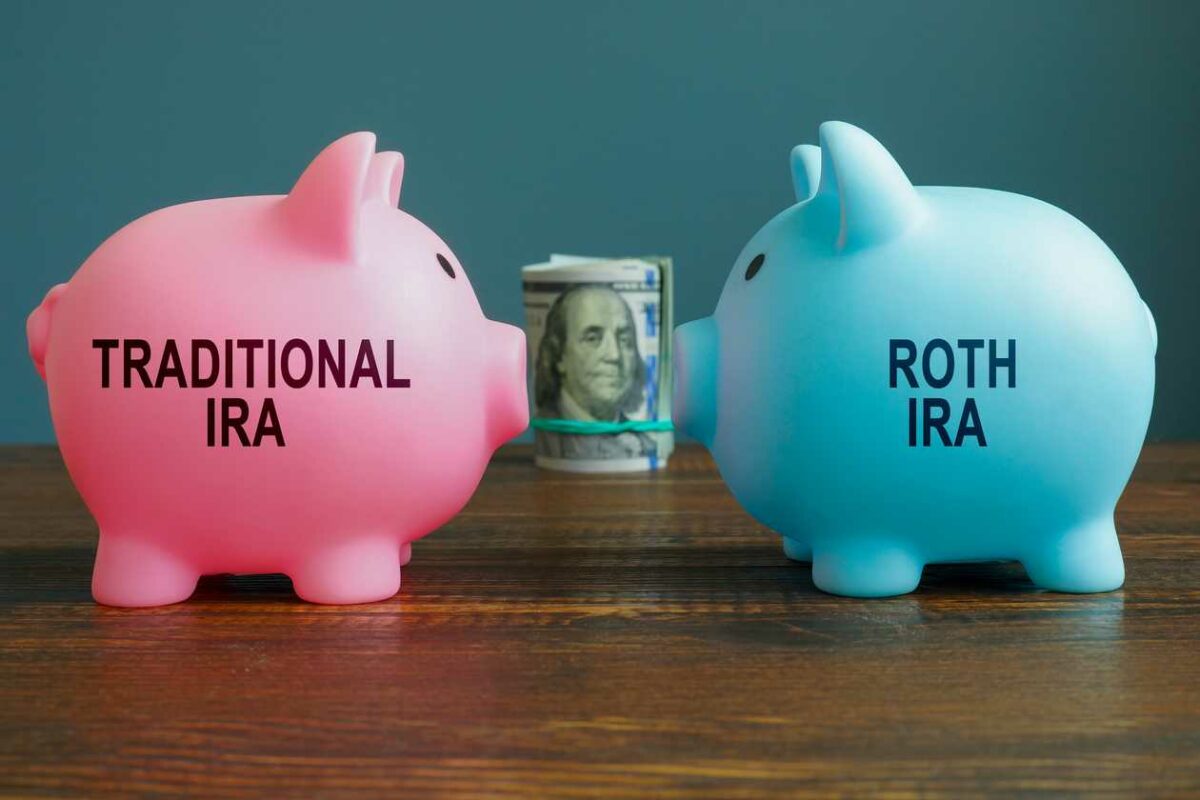I look to the future because that’s where I’m going to spend the rest of my life.
–George Burns
A common question that people have about saving for retirement is whether to save money in a Roth IRA or a traditional IRA.
The biggest difference between the two IRAs is when you are taxed. If you choose the Roth option, then you pay taxes now, and your withdrawals are tax-free. If you choose the traditional option, then your tax bill is decreased, as you, generally, get a deduction for contributing to the traditional IRA, and then, later, when you withdraw from the IRA, you pay ordinary income taxes.
There are several other differences, but, for the sake of this evaluation, let’s not consider those.
Therefore, the big question for Roth IRAs versus traditional IRAs comes down to this:
Should I Pay Taxes Now or Pay Taxes Later

The usual advice for choosing a Roth IRA or a traditional IRA relates to expected future tax rates. If you think that you’ll have a lower tax rate in the future, then it makes sense to pay taxes in the future. If you think that you are going to have a higher tax rate in the future, then it makes sense to pay taxes now.
Or does it?
If you pay taxes now, then you have an opportunity cost for the money that you give to Uncle Sam. That opportunity cost is the inability to invest that money and, hopefully, earn more through your investments. That comes with risk, naturally, but, with a long enough time horizon, there is an opportunity to earn enough money through that investment to make the tradeoff worthwhile.
Additionally, your current and future tax rates do matter. If your tax rate in the future would only be, let’s say, a percent or two higher, then that might not be as meaningful as if it was a LOT higher. Plus, how much does a LOT (this is an official mathematical term, I am sure) have to be in order to cause you to act differently today?
Let’s walk through an example to see how your current choice and future tax rates may affect your decision.
Again, I’m doing a very simple example. You should find a financial planner near you to do the detailed analysis for your specific situation.
Let’s assume that you have a household that has two incomes. The median marginal income tax rate is 21.7%. This means that for each incremental dollar that someone who is in the 50th percentile of income earns, that person will pay 21.7 cents in federal income tax on that dollar.
So, for simplification’s sake, let’s assume that if a family contributes $12,000 to a traditional IRA (which is the 2020 traditional IRA contribution limit), that family would see a $2,604 reduction in income taxes.
That’s $2,604 that doesn’t go into Uncle Sam’s pockets right now, but at a cost of having to pay the tax piper at the time of withdrawal.
Let’s further assume that this is an astute couple, and they invest that $2,604 savings in the stock market. The historical annual return of the S&P 500 (growth plus dividends reinvested) is 9.12%.
While investment growth is great, inflation is a downside. Inflation will chip away at the purchasing power of your money over time. I assumed a 3% average inflation rate.
If this couple has 30 years until retirement and the time when they will need to withdraw money from the traditional IRA and pay ordinary income taxes on it, then we find that:
- The investment of the initial $2,604 has grown to $35,718.21
- It would take $6,320.59 to have the same purchasing power 30 years in the future as $2,604 will buy now
Therefore, in order for this couple to breakeven on a decision to put their money into a traditional IRA instead of a Roth IRA, they would have to have a marginal federal income tax rate of 82.3%.
Time horizons certainly play a role in the breakeven decision. Below, we see that the longer the time horizon until withdrawals start, the higher the breakeven tax rate is.
|
Years to Retirement |
Breakeven Tax Rate |
|
5 |
25.1% |
|
10 |
43.9% |
|
15 |
57.9% |
|
20 |
68.5% |
|
25 |
76.4% |
|
30 |
82.3% |
|
35 |
86.7% |
|
40 |
90.1% |
|
45 |
92.6% |
|
50 |
94.4% |
While there are many other factors that play into the decision as to whether to save money in a Roth IRA or a traditional IRA, this framework can help inform your decision of where you want to stash your retirement dollars.
Author Profile
- John Davis is a nationally recognized expert on credit reporting, credit scoring, and identity theft. He has written four books about his expertise in the field and has been featured extensively in numerous media outlets such as The Wall Street Journal, The Washington Post, CNN, CBS News, CNBC, Fox Business, and many more. With over 20 years of experience helping consumers understand their credit and identity protection rights, John is passionate about empowering people to take control of their finances. He works with financial institutions to develop consumer-friendly policies that promote financial literacy and responsible borrowing habits.
Latest entries
 Low Income GrantsSeptember 25, 2023How to Get a Free Government Phone: A Step-by-Step Guide
Low Income GrantsSeptember 25, 2023How to Get a Free Government Phone: A Step-by-Step Guide Low Income GrantsSeptember 25, 2023Dental Charities That Help With Dental Costs
Low Income GrantsSeptember 25, 2023Dental Charities That Help With Dental Costs Low Income GrantsSeptember 25, 2023Low-Cost Hearing Aids for Seniors: A Comprehensive Guide
Low Income GrantsSeptember 25, 2023Low-Cost Hearing Aids for Seniors: A Comprehensive Guide Low Income GrantsSeptember 25, 2023Second Chance Apartments that Accept Evictions: A Comprehensive Guide
Low Income GrantsSeptember 25, 2023Second Chance Apartments that Accept Evictions: A Comprehensive Guide

